The quinoa starch market is valued at USD 1,180 million in 2025 and is projected to reach USD 2,090 million by 2035, advancing at a CAGR of 5.9%. Growth is driven by the expanding gluten-free food sector, rising preference for natural functional ingredients, and the need for superior starch alternatives in food processing environments. Quinoa starch offers exceptional gel-forming properties, thermal stability, and freeze-thaw resistance, making it suitable for gluten-free bakery products, specialty food manufacturing, nutraceutical formulations, and clean-label applications.
White quinoa accounts for the largest share at 65% due to neutral flavor profiles, high starch content, and compatibility with existing food processing systems, while red and black quinoa support specialized nutritional applications. Food & beverage represents the dominant application at 70% of demand, followed by nutraceuticals as manufacturers expand health-focused product offerings.
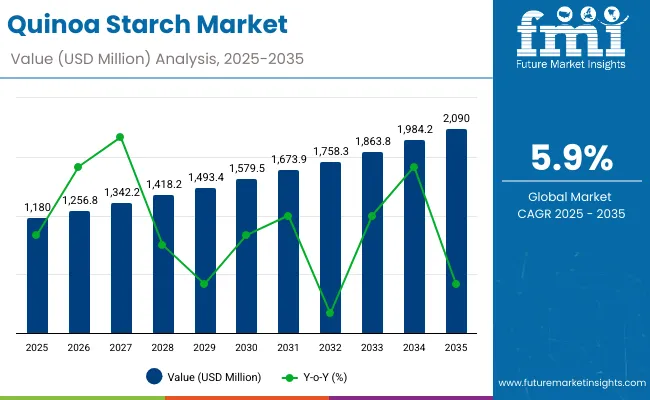
Quinoa Starch Market Key Takeaways
| Metric | Value |
|---|---|
| Market Value (2025) | USD 1,180 million |
| Market Forecast Value (2035) | USD 2,090 million |
| Forecast CAGR (2025 to 2035) | 5.9% |
North America, particularly USA and Canada, leads growth due to rising gluten-free awareness and modernization of food processing systems, while Europe shows strong demand supported by clean-label initiatives. Competition in the quinoa starch market remains moderate, with key companies such as Andean Naturals, Inka Crops, and Jatun Quinoa focusing on extraction technology advancement, product purity optimization, and supply chain reliability to strengthen market positioning.
The science behind quinoa starch's functional properties reveals why this ancient grain derivative has become essential to modern food formulation. When extracted from quinoa seeds through advanced processing techniques, the resulting starch exhibits unique gel-forming properties, thermal stability, and freeze-thaw resistance that make it superior to conventional starches in numerous applications. Quinoa starch particles range from 0.5 to 3 micrometers in diameter, significantly smaller than potato or corn starch granules, providing exceptional texture modification capabilities and enhanced digestibility. The starch content in quinoa seeds varies from 50% to 70%, depending on variety and growing conditions, with white quinoa typically yielding the highest starch concentrations.
The evolution of quinoa starch extraction technology mirrors the increasing demand for premium functional ingredients, progressing from basic mechanical separation methods to sophisticated enzymatic and membrane filtration systems capable of producing high-purity starches with specific functional characteristics. Modern processing facilities utilize multi-stage purification protocols that remove proteins, lipids, and minerals while preserving the native starch structure and functionality. These systems incorporate advanced monitoring technologies that continuously control pH levels, temperature, and processing time to maintain optimal extraction efficiency and product quality standards.
The food industry's transformation toward clean-label formulations has dramatically elevated the importance of natural starch alternatives, as manufacturers seek ingredients that deliver functional performance while meeting consumer demands for recognizable, minimally processed components. Gluten-free bakery products, dairy alternatives, and specialty foods require starch ingredients that provide binding, thickening, and texturizing properties without compromising taste or nutritional value. The growing prevalence of celiac disease and gluten sensitivity, affecting approximately 1% and 6% of the global population respectively, creates substantial demand for reliable gluten-free starch solutions that enable product developers to create appealing alternatives to wheat-based foods.
Between 2025 and 2030, the quinoa starch market is projected to expand from USD 1,180.0 million to USD 1,579.5 million, resulting in a value increase of USD 399.5 million, which represents 43.9% of the total forecast growth for the decade. This phase of development will be shaped by rising demand for gluten-free food products and natural thickening agents, product innovation in food applications and nutraceutical formulations, as well as expanding integration with specialty food manufacturing and clean-label initiatives. Companies are establishing competitive positions through investment in advanced extraction technologies, quality control systems, and strategic market expansion across food processing, cosmetics, and industrial applications.
From 2030 to 2035, the market is forecast to grow from USD 1,579.5 million to USD 2,090.0 million, adding another USD 510.5 million, which constitutes 56.1% of the overall ten-year expansion. This period is expected to be characterized by the expansion of specialty starch applications, including advanced functional ingredients and next-generation food formulations tailored for specific dietary requirements, strategic collaborations between quinoa starch producers and food manufacturers, and an enhanced focus on product differentiation and premium positioning. The growing emphasis on plant-based ingredients and functional foods will drive demand for comprehensive quinoa starch solutions across diverse manufacturing applications.
The quinoa starch market grows by enabling food manufacturers and ingredient suppliers to access premium functional starches while meeting consumer demands for natural, gluten-free alternatives without substantial processing infrastructure investment. Food companies and specialty manufacturers face mounting pressure to develop clean-label products and gluten-free formulations while managing complex functional requirements, with quinoa starch typically providing 40-60% better gel strength compared to conventional alternatives, making natural starch technologies essential for competitive product positioning.
The food industry's need for functional ingredients and application-specific performance creates demand for comprehensive quinoa starch solutions that can provide superior texture modification, maintain consistent quality standards, and ensure reliable functionality without compromising nutritional value or sensory appeal.
Government initiatives promoting ancient grain cultivation and gluten-free food production drive adoption in food processing, nutraceutical manufacturing, and specialty applications, where ingredient quality has a direct impact on product performance and consumer acceptance. However, supply chain limitations during peak demand periods and the processing complexity requirements for high-purity extraction may limit accessibility among smaller food manufacturers and developing regions with limited infrastructure for specialized starch production.
The market is segmented by source, purity level, application, functionality, product format, distribution channel, and region. By source, the market is divided into white quinoa, red quinoa, black quinoa, and mixed/tricolor quinoa. Based on purity level, the market is categorized into native quinoa starch and purified/isolated quinoa starch.
By application, the market includes food & beverage, nutraceuticals, cosmetics & personal care, and industrial applications. Based on functionality, the market is segmented into thickening agent, stabilizer, binder, texturizer, and fat replacer. By product format, the market is divided into powder, granules, and gel applications. Based on distribution channel, the market includes B2B and B2C segments. Regionally, the market is divided into North America, Latin America, Europe, East Asia, South Asia & Pacific, and Middle East & Africa.
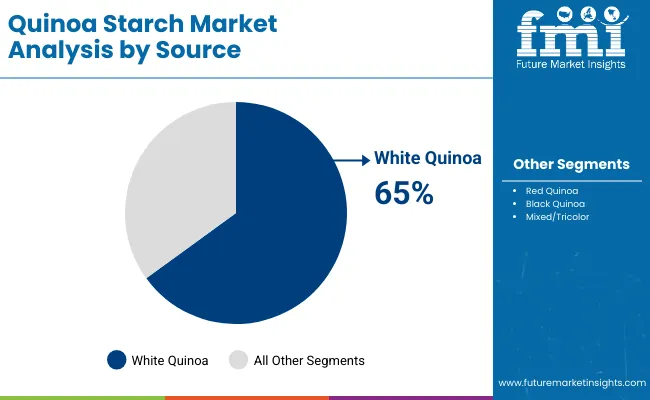
The white quinoa segment represents the dominant force in the quinoa starch market, capturing approximately 65.0% of total market share in 2025. This established source category encompasses solutions featuring neutral flavor profiles and superior processing characteristics, including high starch content and enhanced extraction efficiency that enable superior functional benefits and performance outcomes across all food applications. The white quinoa segment's market leadership stems from its proven processing capabilities, with solutions capable of addressing diverse application requirements while maintaining consistent quality standards and functional effectiveness across all production environments.
The red quinoa segment maintains a substantial 15% market share, serving applications that require enhanced nutritional profiles with distinctive color properties for specialty food and nutraceutical applications. These solutions offer advanced antioxidant capabilities for complex formulations while providing sufficient functional characteristics to meet food processing and manufacturing demands. The black quinoa segment accounts for approximately 8% of the market, serving premium applications requiring specific nutritional properties or specialized processing configurations. The mixed/tricolor quinoa segment holds 12.0% market share, targeting applications that benefit from balanced nutritional profiles and visual appeal.
Key source advantages driving the white quinoa segment include:

Native quinoa starch applications dominate the quinoa starch market with approximately 70.0% market share in 2025, reflecting the critical role of minimally processed starches in supporting natural food formulations and clean-label requirements worldwide. The native quinoa starch segment's market leadership is reinforced by increasing clean-label trends, processing simplicity requirements, and rising needs for natural functional ingredients in food applications across developed and emerging markets.
The purified/isolated quinoa starch segment represents the second-largest purity category, capturing 30.0% market share through specialized requirements for high-performance applications, advanced food processing, and industrial formulations. This segment benefits from growing demand for premium functionality that requires specific purity standards, quality compliance protocols, and performance optimization in specialized markets.
Key market dynamics supporting purity level growth include:
The market is driven by three concrete demand factors tied to food industry outcomes. First, gluten-free product development and clean-label formulations create increasing demand for natural starch alternatives. Second, government initiatives promoting ancient grain production and gluten-free food regulations drive increased adoption of quinoa-based ingredients, with many countries implementing dietary guidelines and food labeling frameworks for allergen management by 2030. Third, technological advancements in starch extraction and food applications enable more efficient and effective processing solutions that improve product functionality while reducing production costs and processing complexity.
Market restraints include complex supply chain management and quality control costs for specialty starch production that can challenge market participants in developing consistent sourcing capabilities, particularly in regions where quinoa cultivation remains limited and processing infrastructure uncertain. Technical complexity of high-purity starch extraction and functionality requirements pose another significant challenge, as quinoa starch demands sophisticated processing methods and quality controls, potentially affecting production costs and operational efficiency. Seasonal availability constraints from quinoa harvesting cycles across different growing regions create additional supply challenges for manufacturers, demanding ongoing investment in inventory management and procurement diversification programs.
Key trends indicate accelerated adoption in Europe and South Asia & Pacific markets, particularly Germany and India, where food innovation and health-conscious consumption drive comprehensive quinoa starch adoption. Technology integration trends toward purified starch systems with enhanced functional characteristics, advanced food applications, and integrated processing solutions enable effective manufacturing approaches that optimize food quality and minimize processing risks. However, the market thesis could face disruption if significant advances in alternative natural starches or major changes in gluten-free regulations reduce reliance on traditional quinoa starch applications.
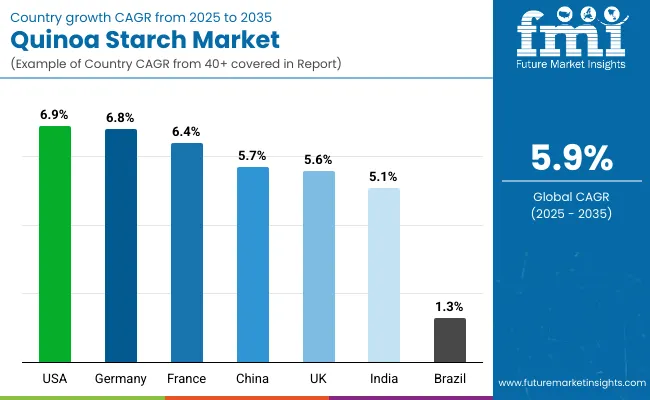
| Countries | CAGR (%) |
|---|---|
| USA | 6.9 |
| Germany | 6.8 |
| France | 6.4 |
| UK | 5.6 |
| China | 5.7 |
| India | 5.1 |
The global quinoa starch market is expanding steadily, with USA leading at a 6.9% CAGR through 2035, driven by gluten-free product innovation, consumer health awareness, and advanced food processing capabilities. Germany follows at 6.8%, supported by clean-label initiatives, food technology advancement, and specialty ingredient development programs. France records 6.4%, reflecting an established market with growing integration in premium food applications and artisanal manufacturing.
China advances at 5.7%, focusing on ingredient diversification and manufacturing modernization. UK demonstrates 5.6% growth, driven by gluten-free market expansion and premium food ingredient adoption. India grows steadily at 5.1%, emphasizing traditional grain modernization and health food development. Brazil posts 1.3%, representing emerging market opportunities with agricultural development potential.
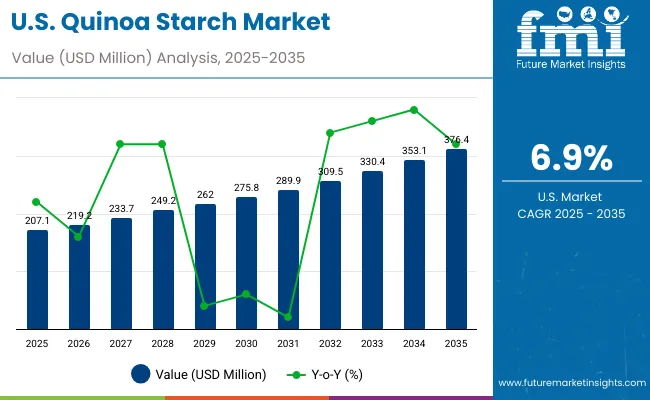
USA demonstrates the strongest growth potential in the quinoa starch market with a CAGR of 6.9% through 2035. The country's leadership position stems from gluten-free food market expansion, consumer health consciousness, and comprehensive food processing regulations driving the adoption of advanced quinoa starch solutions.
Growth is concentrated in major food manufacturing and processing centers, including California, Illinois, New York, and Texas, where food companies and ingredient suppliers are implementing advanced starch systems for enhanced product capabilities and market differentiation. Distribution channels through ingredient suppliers and food manufacturers expand deployment across manufacturing facilities and product development initiatives. The country's Food and Drug Administration provides regulatory support for specialty ingredient approval, including comprehensive food safety development.
Key market factors:
In major food manufacturing and processing centers including Bavaria, North Rhine-Westphalia, Baden-Württemberg, and Lower Saxony, the adoption of comprehensive quinoa starch solutions is accelerating across product development projects and ingredient innovation initiatives, driven by clean-label trends and government food quality programs. The market demonstrates strong growth momentum with a CAGR of 6.8% through 2035, linked to comprehensive food industry modernization and increasing focus on natural ingredient solutions.
German companies are implementing advanced quinoa starch systems and processing technologies to enhance product performance while meeting growing demand in expanding specialty food and health-focused manufacturing sectors. The country's food innovation initiatives create continued demand for functional ingredients, while increasing emphasis on quality drives adoption of premium starch systems.
Key development areas:
France's market expansion is driven by diverse culinary demand, including artisanal food manufacturing development in major regions and comprehensive specialty product projects across multiple applications. The country demonstrates strong growth potential with a CAGR of 6.4% through 2035, supported by government food quality programs and industry-level ingredient development initiatives.
French companies face implementation challenges related to supply chain complexity and quality requirements, requiring strategic development approaches and support from specialized ingredient partners. However, growing premium food demands and artisanal manufacturing requirements create compelling business cases for quinoa starch adoption, particularly in specialty food areas where natural ingredients have a direct impact on product quality and market positioning.
Market characteristics:
The UK market leads in premium ingredient integration based on consumer health awareness and specialty food development for enhanced product positioning. The country shows strong potential with a CAGR of 5.6% through 2035, driven by the modernization of existing food manufacturing infrastructure and the expansion of gluten-free processing facilities in major industrial areas, including England, Scotland, Wales, and Northern Ireland.
British companies are adopting quinoa starch systems for product enhancement and market differentiation, particularly in regions with health-focused food requirements and specialty applications demanding comprehensive ingredient upgrades. Technology deployment channels through established food institutions and ingredient suppliers expand coverage across manufacturing facilities and innovation-focused applications.
Leading market segments:
Brazil's quinoa starch market represents an emerging opportunity with significant agricultural development potential, demonstrating steady growth at a CAGR of 1.3% through 2035. The country's growth trajectory reflects the early-stage development of quinoa cultivation infrastructure and processing capabilities in major agricultural regions, including São Paulo, Minas Gerais, Rio Grande do Sul, and Paraná, where agricultural companies and food manufacturers are exploring quinoa starch applications for domestic and export markets.
Brazilian companies face development challenges related to quinoa cultivation adaptation and processing technology implementation, requiring strategic agricultural approaches and support from international ingredient partners. However, growing health food demands and agricultural diversification initiatives create foundation opportunities for quinoa starch adoption, particularly in specialty food areas where natural ingredients support product innovation and market development.
Market development factors:
China's quinoa starch market demonstrates established and technology-focused landscape, characterized by growing integration of starch systems with existing food processing infrastructure across manufacturing projects, ingredient networks, and modernization initiatives. China's emphasis on food industry expansion and ingredient innovation drives demand for functional starch solutions that support comprehensive manufacturing initiatives and processing requirements in food operations.
The market benefits from partnerships between international ingredient providers and domestic food manufacturers, creating supply ecosystems that prioritize processing excellence and quality programs. Industrial centers in major regions showcase developing starch system implementations where processing systems achieve efficiency improvements through integrated manufacturing programs.
Market development factors:
India's quinoa starch market demonstrates growing potential through agricultural modernization and health food development initiatives, showing steady expansion at a CAGR of 5.1% through 2035. The country's development focuses on quinoa cultivation programs and processing infrastructure establishment in major agricultural regions, including Maharashtra, Gujarat, Karnataka, and Rajasthan, where farmers and food companies are exploring quinoa production for domestic consumption and ingredient applications.
Indian companies are implementing quinoa cultivation and basic processing systems to enhance agricultural diversification while meeting growing demand in expanding health food and specialty ingredient sectors. The country's agricultural development programs create continued demand for crop diversification and modernization solutions that align with traditional farming practices and emerging food industry requirements.
Key development areas:

The quinoa starch market in Europe is projected to grow from USD 407.0 million in 2025 to USD 724.3 million by 2035, registering a CAGR of 5.9% over the forecast period. Germany is expected to maintain its leadership position with a 20.0% market share in 2025, projected to reach USD 138.0 million by 2035, supported by its extensive food processing infrastructure, advanced manufacturing facilities, and comprehensive ingredient networks serving major European markets.
UK follows with a 16.0% share in 2025, projected to reach USD 109.0 million by 2035, driven by comprehensive gluten-free food programs in major processing regions implementing advanced starch systems. France holds a 14.0% share in 2025, expected to reach USD 94.0 million by 2035 through the ongoing development of specialty food facilities and artisanal networks. Italy commands a 10.0% share projected to reach USD 72.0 million, while Spain accounts for 8.0% expected to reach USD 58.0 million in 2035.
BENELUX region maintains 6.0% share projected to reach USD 43.0 million, while Nordic countries hold 5.0% expected to reach USD 36.0 million by 2035. The Rest of Europe region is anticipated to maintain momentum with 21.0% share, reaching USD 152.0 million by 2035, attributed to increasing starch system adoption in Eastern European countries and emerging food processing facilities implementing ingredient programs.
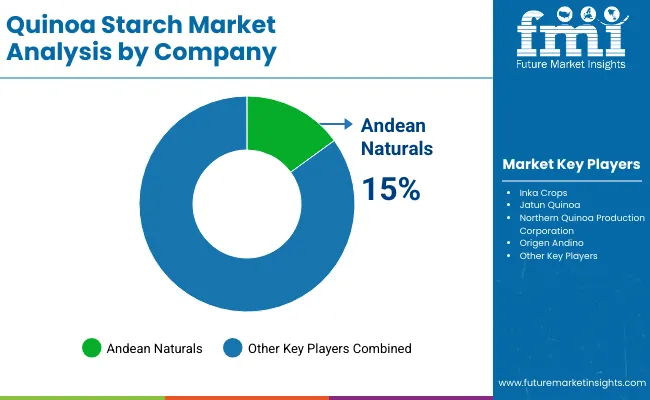
Andean Naturals (quinoa operations now owned and operated by Ardent Mills’ specialty grain division), Inka Crops, and Jatun Quinoa, are among the leading players. Challengers encompass Northern Quinoa Production Corporation and Origen Andino, which compete through specialized processing technologies and strong regional presence in key quinoa growing markets. Industry specialists focus on specific applications or vertical markets, offering differentiated capabilities in high-purity systems, functional applications, and application-specific processing.
Regional players and emerging ingredient companies create competitive pressure through innovative extraction approaches and rapid development capabilities, particularly in high-growth markets including USA and Germany, where local presence provides advantages in cost optimization and regulatory compliance. Market dynamics favor companies that combine advanced processing technologies with comprehensive food industry services that address the complete supply chain from sourcing through ongoing quality assurance and technical support.
| Items | Values |
|---|---|
| Quantitative Units (2025) | USD Million |
| Source | White Quinoa, Red Quinoa, Black Quinoa, Mixed/ Tricolor Quinoa |
| Purity Level | Native Quinoa Starch, Purified/Isolated Quinoa Starch |
| Application | Food & Beverage, Nutraceuticals, Cosmetics & Personal Care, Industrial |
| Functionality | Thickening Agent, Stabilizer, Binder, Texturizer, Fat Replacer |
| Product Format | Powder, Granules, Gel |
| Distribution Channel | B2B, B2C |
| Regions Covered | North America, Latin America, Europe, East Asia, South Asia & Pacific, Middle East & Africa |
| Countries Covered | USA, Germany, France, UK, South Korea, Japan, China, India, and 40+ countries |
| Key Companies Profiled | Andean Naturals, Inka Crops, Jatun Quinoa, Northern Quinoa Production Corporation, Origen Andino |
| Additional Attributes | Dollar sales by source and purity level categories, regional adoption trends across Europe, South Asia & Pacific, and North America, competitive landscape with ingredient providers and food companies, processing facility requirements and specifications, integration with food development initiatives and specialty platforms, innovations in extraction technology and processing systems, and development of functional applications with quality assurance and operational optimization capabilities. |
The global quinoa starch market is valued at USD 1,180 million in 2025, supported by rising gluten-free food production, clean-label demand, and wider adoption of natural starch alternatives across bakery, dairy, nutraceutical, and specialty food applications.
By 2035, the quinoa starch market is forecast to reach USD 2,090 million, driven by expanding functional food applications, premium ingredient requirements, and broader adoption of native and purified quinoa starch across global processing systems.
The market is projected to grow at a 5.9% CAGR between 2025 and 2035, reflecting steady expansion in gluten-free manufacturing, specialty ingredient development, and clean-label product formulation.
White quinoa dominates with 65% share in 2025, supported by higher starch yield, neutral flavor, and strong compatibility with commercial food processing and extraction systems.
Food & beverage leads with 70% market share in 2025, followed by nutraceuticals, cosmetics, and industrial applications that use quinoa starch for thickening, binding, stabilizing, and texture enhancement.






Our Research Products

The "Full Research Suite" delivers actionable market intel, deep dives on markets or technologies, so clients act faster, cut risk, and unlock growth.

The Leaderboard benchmarks and ranks top vendors, classifying them as Established Leaders, Leading Challengers, or Disruptors & Challengers.

Locates where complements amplify value and substitutes erode it, forecasting net impact by horizon

We deliver granular, decision-grade intel: market sizing, 5-year forecasts, pricing, adoption, usage, revenue, and operational KPIs—plus competitor tracking, regulation, and value chains—across 60 countries broadly.

Spot the shifts before they hit your P&L. We track inflection points, adoption curves, pricing moves, and ecosystem plays to show where demand is heading, why it is changing, and what to do next across high-growth markets and disruptive tech

Real-time reads of user behavior. We track shifting priorities, perceptions of today’s and next-gen services, and provider experience, then pace how fast tech moves from trial to adoption, blending buyer, consumer, and channel inputs with social signals (#WhySwitch, #UX).

Partner with our analyst team to build a custom report designed around your business priorities. From analysing market trends to assessing competitors or crafting bespoke datasets, we tailor insights to your needs.
Supplier Intelligence
Discovery & Profiling
Capacity & Footprint
Performance & Risk
Compliance & Governance
Commercial Readiness
Who Supplies Whom
Scorecards & Shortlists
Playbooks & Docs
Category Intelligence
Definition & Scope
Demand & Use Cases
Cost Drivers
Market Structure
Supply Chain Map
Trade & Policy
Operating Norms
Deliverables
Buyer Intelligence
Account Basics
Spend & Scope
Procurement Model
Vendor Requirements
Terms & Policies
Entry Strategy
Pain Points & Triggers
Outputs
Pricing Analysis
Benchmarks
Trends
Should-Cost
Indexation
Landed Cost
Commercial Terms
Deliverables
Brand Analysis
Positioning & Value Prop
Share & Presence
Customer Evidence
Go-to-Market
Digital & Reputation
Compliance & Trust
KPIs & Gaps
Outputs
Full Research Suite comprises of:
Market outlook & trends analysis
Interviews & case studies
Strategic recommendations
Vendor profiles & capabilities analysis
5-year forecasts
8 regions and 60+ country-level data splits
Market segment data splits
12 months of continuous data updates
DELIVERED AS:
PDF EXCEL ONLINE
Starch-based Texturizing Agents Market Size and Share Forecast Outlook 2025 to 2035
Quinoa Seed Market Size and Share Forecast Outlook 2025 to 2035
Starch-based Packaging Market Size and Share Forecast Outlook 2025 to 2035
Starch-derived Fiber Market Size and Share Forecast Outlook 2025 to 2035
Starch-Based Bioplastics Packaging Market Insights - Growth & Forecast 2025 to 2035
Starch Derivatives Market by Product Type, Source, End Use and Region through 2035
Starches/Glucose Market
Starch Glucose Syrup Market
Starch Recovery Systems Market Outlook – Growth, Demand & Forecast 2023-2033
Distarch Phosphate Market Size and Share Forecast Outlook 2025 to 2035
UK Starch Derivatives Market Report – Size, Share & Innovations 2025-2035
Cornstarch Packaging Market Size and Share Forecast Outlook 2025 to 2035
Monostarch Phosphate Market Size and Share Forecast Outlook 2025 to 2035
Pea Starch Market Analysis - Size, Share, and Forecast Outlook 2025 to 2035
USA Starch Derivatives Market Analysis – Demand, Trends & Outlook 2025-2035
Pea Starch Concentrate Market Trends - Growth & Industry Forecast 2025 to 2035
Food Starch Market Analysis - Size, Share, and Forecast Outlook 2025 to 2035
Wheat Starch Market Size and Share Forecast Outlook 2025 to 2035
ASEAN Starch Derivatives Market Trends – Growth, Demand & Forecast 2025-2035
Millet Starch Market Size and Share Forecast Outlook 2025 to 2035

Thank you!
You will receive an email from our Business Development Manager. Please be sure to check your SPAM/JUNK folder too.
Chat With
MaRIA